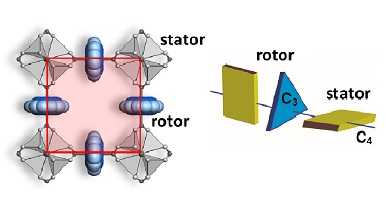
Solid, liquid or gaseous: these are the different states that matter takes according to external parameters such as temperature and pressure. Let us think of water: in fluid states it cannot be handled like a material, instead ice can even be sculpted. However, when cold, all the matter freezes and stiffens: the molecules themselves move only minimally or very slowly, instead for a solid material to be active it must be endowed with a certain degree of mobility, typical of liquids. The real challenge is to design and build a material from its molecular elements to go into the territory where the boundaries between the states of matter are mixed to have the advantages that each of them can give: a dynamic solid state component can have consequences absolutely innovative on the final properties of the material.
Thanks to the collaboration of a group of researchers from the Department of Materials Science of the University of Milan-Bicocca led by Prof. Piero Sozzani, professor of Industrial Chemistry, and with the collaboration of the Physics Department of the University of Pavia, it was possible obtain a highly porous crystalline material (Metal-Organic Framework, MOF) in which molecular rotors with a record rotation speed in the Gigahertz regime still at 2K (-271 °C) have been inserted. These fast solid-state rotors are supported by a fixed crystalline scaffold that acts as a stator. The high porosity of the MOFs is such that each rotating molecular group has a lot of empty space around it and, therefore, cannot be negatively affected by the crystalline surroundings. The results of this research were recently published in Nature Chemistry in the article entitled "Fast motion of molecular rotors in metal-organic framework struts at very low temperatures" (doi: 10.1038 / s41557-020-0495-3).
Why is it important to have a solid with the dynamics of a liquid?
The ability to provide matter with an internal dynamics equal to that of liquids is extremely important because many functions and applications are precluded for intrinsically rigid and static systems: - explains Prof. Sozzani - yet, these dynamic properties must be established without sacrificing the solidity and robustness of the material as a whole. These dynamical aspects are related to the possibility of building 'molecular motors and rotors' that can perform collective work, while anchored and pivoted within the solid material, thus carrying out magnetic, ferroelectric properties or stimulated color change. All these properties are directly or indirectly linked to the persistence of mobility in the solid.
The research activity on artificial molecular machines finds its fundamental purpose in the control over the dynamic properties of active molecules in order to perform work and useful mechanical operations on a nanometric scale, as in the exemplary cases of molecular switches and actuators. In the engines of everyday life (for example cars), the rotating components play a fundamentally important role; in the same way, the realization of molecular motors requires that continuous and 'fluid' rotating molecular units are available.
What scientific innovation did the research published in Nature Chemistry lead to?
We reached the maximum mobility obtainable in a solid containing molecular rotors - continues Prof. Sozzani - and we pushed ourselves to study its dynamics up to 2 K (-271 °C): with very low energy requirements it is sufficient to animate the motion of a group of atoms coherently around a suitably designed stable axis of rotation. This led to a real record of mobility and very low energy (only 6 small calories per mole), that is, almost nothing in the molecular world. More importantly, the material does not undergo transitions, i.e. modifications, due to the lowering of temperatures in such extreme regions. Surprisingly, rotational speeds are recorded in the Gigahertz regime still at 2K, as observed by solid state Nuclear Magnetic Resonance.
What are the principles that led to the discovery?
The alchemy for the fabrication of the dynamic crystalline architecture includes in-depth knowledge of molecular self-assembly, starting from the preparation of the construction elements, how pillars and beams are prepared on a macroscopic construction site - explains Prof. Sozzani. - The result is not at all obtained randomly or for so-called 'serendipity', but by a specific design process, which is the most fascinating feature of modern Materials Science: construction aimed at achieving new properties.
We have indeed kept in mind many aspects such as large free volume and very low energy at the rotation pivot generated by the application of elements of symmetry of the various groups of atoms and the crystalline symmetry of the whole structure. Specifically, the compensation and frustration of the elements of symmetry has led to an extremely flat and 'sliding' rotation energy profile. The new category of rotors has been defined as FTR "rotors with frustrated trigonal symmetry".
The low rotation barriers created, lower than the thermal energy at 2 K, will allow the construction of molecular motors and rotors which extend their existence domain to the extreme limit of very low temperatures: at that limit, the incoherent thermal agitation becomes negligible, making it possible to manufacture molecular motors with coherent motion that can work undisturbed.